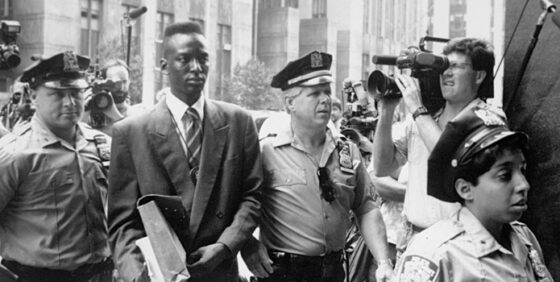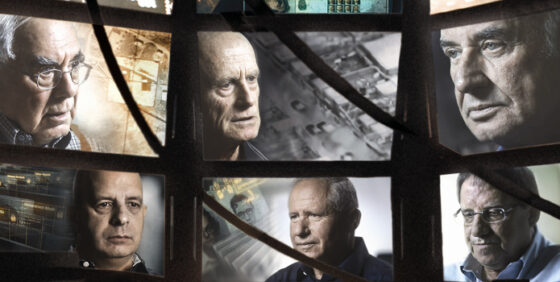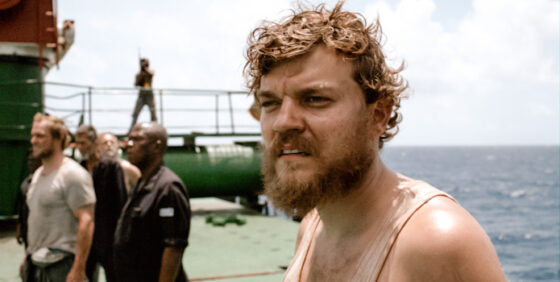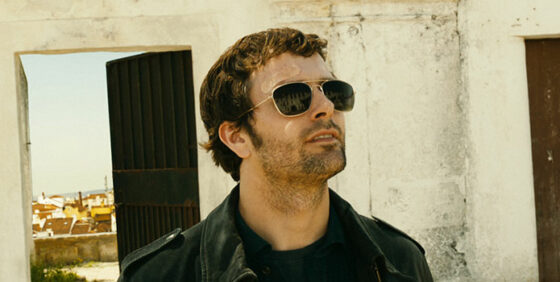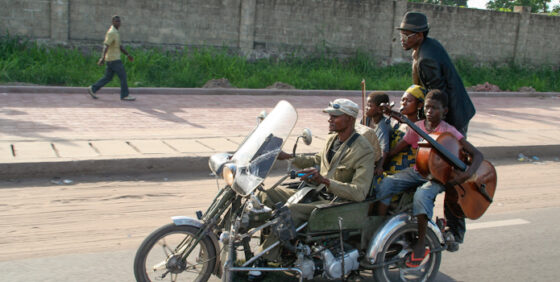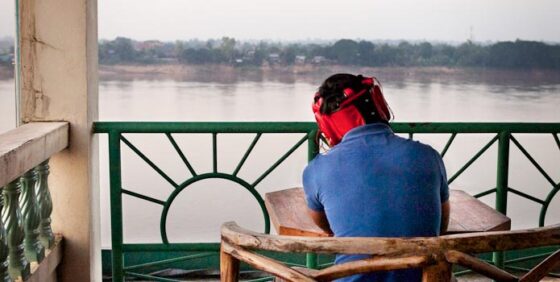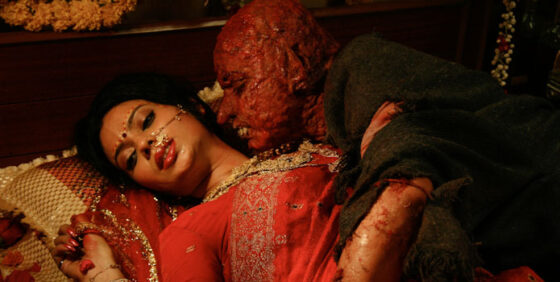TIFF Preview -3: autrement, la Molussie | Post Tenebras Lux | The Central Park Five | The Gatekeepers | A Hijacking | iLL Manors | Imagine | Kinshasa Kids | Mekong Hotel | Miss Lovely | Penance | To the Wonder
Cinema Scope 52 Preview
Burru’s Abominable Dialectic: Nicolas Rey’s autrement, la Molussie (France)—Wavelengths
By Michael Sicinski
In composing this essay on Nicolas Rey’s latest film, I have opted to follow a principle similar to the one that gives his film its overall shape. The essay consists of six semi-autonomous sections, which I have assigned an order using a random-number generating system. There were also additional sections that, according to the randomizing system, have been omitted. This gap-creation system, then, is my own variant on Rey’s method.
The Time Reels
Among the many unique aspects of autrement, la Molussie, there is one that stands out as its boldest and most defining aesthetic element. The 80-minute feature is comprised of nine individual reels of varying lengths, and Nicolas Rey has designed the film so that their order of presentation should be randomly assigned. (Each reel is designated by a differently coloured title card: a pink reel, a green reel, a canary reel, etc.) That is, Rey has built the film from modules, each thematically linked to the others while retaining semi-autonomy with respect to order, narrative, and spatial orientation. They must all appear once, but can appear in any sequence. (This would mean that there are 362,800 different permutations, or distinct possible versions, of autrement, la Molussie.) This is another method by which Rey inserts chance into his work, similar to the manner in which his hand-processing technique permits a range of uncontrolled effects that nonetheless proliferate within certain parameters. This artistic attitude—to make formal decisions as boundaries for chance procedures, within which “accidents” of a particular stripe may or may not occur—of course has a long history, from Duchamp and Cage through Oulipo and the minimalists and beyond. What is interesting about Rey’s treatment of reel randomization in autrement, la Molussie, I think, is that it enfolds the passages of Anders’ novel within a filmic time that is “flattened” or relegated to a universally applicable principle—it could be the first, the last, or some floating middle, a slice of what Deleuze might have called “any time whatever.” In this regard, Rey renegotiates the narrative time of The Molussian Catacomb into a kind of thinly spread simultaneity, an all-over “time field,” not unlike the colour field of a painter’s canvas. Not only does everything happen at once, but in a theoretical timeframe of perpetual diegetic present. The inescapable historical resonances within Anders’ imaginary tale of Molussia—to Nazi Germany, but to various other times including our own—all become equally present through Rey’s unusual presentation. In this way autrement, la Molussie taps into Benjamin’s specific idea of allegory, since rather than one (fictional) timeframe standing in for another, the very vacuity of certain of history’s gestures allows for their multivalent signification. The mundane exercise of power can represent itself in different circumstances while ironically retaining its specificity.
Olo and Yegussa
Günther Anders wrote The Molussian Catacomb between 1932 and 1936. Thus far, the novel has not been published in either French or English translation. (An Italian translation does exist, however, which seems germane to the book’s subject matter.) The novel details social and political goings-on in an imaginary totalitarian state known as Molussia. While the intended target of Anders’ dark satire is rather transparent—Molussia is ruled by a Hitler figure known as Burru, who even goes so far as to hold a dubious plebiscite on his leadership—for the most part The Molussian Catacomb addresses the question of tyranny from a more philosophical perspective. Much of the dialogue consists of discussions between Olo, an older teacher-figure, and Yegussa, his younger and less learned interlocutor. Segments of the book which are actually about other characters, and which Nicolas Rey adapts for use in autrement, la Molussie, are frequently framed as anecdotes or reportage volleyed between Olo and Yegussa. In formal terms, Anders is employing what we would call “free indirect discourse,” a favoured literary technique of Pasolini in both his films and his writings. But there is also an unmistakable Platonic tenor to these dialogues, with Olo inculcating Yegussa into a key point of knowledge through dialectical intercourse. This is most apparent in the “baby blue” reel, “The Positive is Invisible.” In discussing the consequences of a strike, Olo explains to Yegussa that we cannot feel air (the positive), only its absence (the negative). Likewise, the power base has no direct experience of the (positive) function of labour, only its (negative) impact during a work stoppage. (During this segment, Rey shows us trees in all manner of light and then, suddenly, a barren industrial landscape—the loss of the forest, the removal of oxygen.)
What Taxonomies Are
In the “periwinkle” reel of autrement, la Molussie, “What Relations Are,” Nicolas Rey depicts a nondescript exurban motorway, positioning the camera just off the side of the road. Suddenly, the camera spins in a circle while retaining its firm z-axis. The highway whirls in a clockwise motion, comes to rest, and then bobs back a bit counter-clockwise, not unlike a washing machine. For much of the rest of this segment, Rey presents stock-still shots of a suburban village, notable mainly for the blocky modernism of its two-story bungalows. The sequence immediately calls to mind the films of Michael Snow (La region central [1971] in particular) and Heinz Emigholz, and the spinning camera appears elsewhere in autrement, la Molussie. But instead of registering as mere references, these moments signify relationships or differences, the ways in which Rey is thinking about film history and autrement, la Molussie unique approach to it. Snow’s camera was about its ability to pivot and gyrate in 360 degrees in every direction, so when we see Rey’s camera “move” the horizon line upside down and side to side, we’re also seeing it keep its forward gaze wholly intact. Likewise, when Rey shows us the modernist homes, we’re seeing how much more an Emigholz film would reveal, and how autrement, la Molussie is in many ways a concealing film. In this section, there is a dialogue from Anders’ book, one between Olo and Yegussa. Yegussa asks his master how one should begin to analyze a problem, given that everything is connected. Olo stipulates that, in the great chain of things, “relations” exist in the bracket between that which is closest and that which is furthest away. Or, as Olo puts it, “between the ruffians and the astronomers.” That’s to say, those things that are too close to us, we can meet with petty annoyance. And those things that are too distant, we examine with mere dispassion. In the middle of those extremes lay relations. If we extend this to Rey’s own film, we can think about the sorts of film-historical touchstones autrement, la Molussie engages, and what constitutes a meaningful relation. Too close, and we’d feel the need to assert that Rey had some “connection” to this or that artist; too distant, and we’d simply be trainspotting. But when we postulate taxonomies that might not be so direct, but perhaps gesture toward a kinship—say, to Patrick Keiller’s treatment of landscape as sedimented history, or Bernd and Hilla Becher’s framing of industrial structures as Benjaminian remnants of lost utopias, or Ben Rivers’ recent Slow Action (2010) as a similar filmic mode of visualizing past and future by narrating images of the present—then we are talking about relations, ones that hold the potential to instruct without closing down other possible meanings.
Texts of Light
Nicolas Rey’s cinema is identifiable virtually from the very first frame. He always works in 16mm, and is known for managing every aspect of his processing and production. A true artisan, Rey hand-processes and prints every inch of his films (most of which are feature-length or longer) in order to control their overall texture, grain, exposure, colour correction, optical printing, etc., for maximum expressive ends. Granted, “control” may be a word that overstates the case in some senses, because Rey’s aesthetic—for instance, his deliberate use of outdated film stocks for some films—is one that courts chance. His mode of hand-processing often incorporates pockmarks and scratches on the celluloid, frequently at rhythmic intervals, as a kind of skin or patina, the “maker’s mark” in a situation that is too frequently industrialized (or digitized) into anonymous sterility. Nevertheless, Rey has mastered his craft to such a degree that, while there are indeed wide variances in the look and feel of the different passages of his films, he has (literally) developed a style. Images (often medium-long or long-shots or pans) come together from swirling grains, lending the event an almost molecular look. Light in a Rey film is actively forming the sight onscreen, providing even contemporary events with a hint of History’s loss, that old Death at Work wherein the profilmic object, formed as it was by a momentary collision between photons and a semi-solid spatial arrangement, is, in the words of Jonas Mekas, lost, lost, lost.
The Abomination of Praxis
Nicolas Rey is an axiom of the French experimental film community, but in many respects that still does not provide as high of a profile in North America as it probably should. There are certain material difficulties that can produce an unintentional parochialism in the avant-garde film world, mostly having to do with the costs of shipping prints between continents. Programmers, who don’t have as much money as they used to, find it harder to rent from LUX in London or Light Cone in Paris when they could get more films for less from the CFMDC or the Filmmakers’ Co-op. (The Austrians avoid this problem; Sixpack Film has a US office in Marfa, Texas.) So regrettably, evidence of the bustling French avant-garde scene arrives on these shores in tiny bursts—an Olivier Fouchard film here, a Cécile Fontaine film there. What’s more, compared with so many others, Rey is not particularly prolific. This has to do with his penchant for making experimental features, practically a dying art in 16mm. But just as much as any of his films, one of Rey’s major “works” is L’Abominable, the cooperatively run artists’ lab founded in 1996 and situated in Asnières-sur-Seine until earlier this year, when they relocated to La Courneuve. Giving the lie to gleeful prognosticators of doom who bray about the death of celluloid at the hands of digital imaging, the artists of L’Abominable continue to produce film, and to do so very economically. (The Double Negative group in Montréal emerged from this very same ethic.) The wide variety of films that have been made at L’Abominable (works by Christopher Becks, Pip Chodorov, Frédérique Devaux, Emmanuel Lefrant, Marcelle Thirache, and many others) demonstrates just what can be accomplished when lab work itself is treated as a component of the creative process. But in a broader sense, the Marxist philosophy and analysis that is threaded throughout all of Rey’s major works, including autrement, la Molussie, clearly finds practical expression in his role as co-founder of L’Abominable.
But Differently How?
Nicolas Rey has built a pun into the title of his latest film. But at the same time, he has not. This could be construed as a dialectical manoeuvre, although whether or not to read it as such involves a decision based on history and linguistic heritage. Since The Molussian Catacomb was written by Günther Anders, the original German title of Rey’s film is little more than an authorial designation: “Anders, Molussian.” It’s a code of sorts, taking the title of the original while signifying a relationship with it, rather than a conventional adaptation. Ironically, it seems that sometimes calling on the author can signal an attenuated approach between the source text and the newer one—Fortini/Cani (1977) or Effi Briest (1974), for example—and that’s certainly the case here. Even seemingly straightforward nomenclature like Baz Luhrmann’s William Shakespeare’s Romeo + Juliet (1996) was an unbranding of sorts. However, “Anders” was the author’s assumed name. He knew that auf Deutsch it meant “differently” or “otherwise,” and so Rey’s title “pun” is not even built into the original text, The Molussian Catacomb, but into the very name of the author, a true Derridian conundrum. So, the English title really is (or could be), differently, Molussia. But of course, Rey had every right—in the strongest sense of that word, every legal right, the very name of the author—to retain the name “Anders” without translation, to avoid the chiasmus. So how is differently, Molussia “differently?” How does it signify differently? Even if we postpone the question of how the film itself signifies differently, it seems clear that it adapts differently, that it treats its text of instigation with an almost sculptural sense of play beyond that seen even in Fassbinder or Straub-Huillet.
Post Tenbras Lux (Carlos Reygadas, Mexico/France/The Netherlands/Germany)—Wavelengths
By Tom Charity
Hand it to Cannes: where else do art films get booed? On the rest of the planet, your typically well-adjusted art-house aficionado understands to appreciate whatever challenges the filmmaker has set…or the viewer walks out. To be sure, there are walkouts here too, but a good many hardier souls take it upon themselves to sit, suffering, through a movie they despise, for the privilege of giving voice to their displeasure…As if the Salle Debussy were a gladiatorial arena, in which the jeers of the crowd can push Caesar’s thumb north or south, and condemn the object of derision into well-deserved obscurity.
Not so fast! Vilification is often enough the first step to vindication; from L’Avventura (1960) to The Brown Bunny (2003) there’s a long, ignoble tradition of films that were repudiated by the Cannoises on first sight, only to be resurrected in the next breath. The most noisily derided films have a way of becoming the hottest tickets. Lars von Trier seems to have calibrated his career to just this phenomenon. And this year, Leos Carax and Carlos Reygadas battled it out for the distinction of the festival’s most contentious Competition offering. (That is, if we don’t count the five Americans, which we don’t.) Holy Motors came away from the festival with nothing but distribution deals, while—in the pressroom—Reygadas was booed all the way to his Best Director prize.
Why the hate? Is it a coincidence that these two very different films were also the most experimental Competition entries? They share some common surrealist strategies: disruption, disturbance, graphic sex, sexy graphics…In the most general terms, both filmmakers are casting about for new ways forward, breaking from conventional narrative structures and pushing their mise en scène into unexpected places. Are we still so resistant to the shock of the new? Or is the opposite the case, that we’ve become all too familiar with the provocations of the avant-garde? Like von Trier, Reygadas is seen in some quarters as a phony, a self-aggrandizer specializing in sexed-up Dreyer and Tarkovsky knock-offs; a purveyor of pervy transcendentalism.
These twinned films maudit are markedly different though. Carax is consciously playing with formal tropes—serving up parodic, postmodern variants on the likes of The Phantom of the Opera and the hit-man movie, riffing on Cocteau and Franju, and exploring acting and performance as metaphors for employment and human connectivity. In contrast, at least at first, Reygadas seems to be groping in the dark, going off-map as he seeks to exorcize his personal demons. Back in 2010 he announced his intention to make an expressionist film “where reason will intervene as little as possible.” For many first-time viewers it seems he succeeded all too well.
If Post Tenebras Lux (Latin for “After Darkness, Light”) presents itself as a problematic film, part of the challenge is simply to connect the dots, to figure out what we’re seeing and how it relates to what we’ve seen before. While Reygadas makes it difficult with his achronological, non-linear structure, and the occasional “stray” episodes that defy narrative exegesis (notably two scenes involving an English schoolboy rugby team, which reportedly derive from the director’s memories of public school abroad), the film does coalesce around one affluent, young nuclear family who have retreated to the edges of a remote, rural community, and, in particular, on the man, Juan (Adolfo Jimenez Castro), and his strained relationship with his wife, Nathalia (Nathalia Acevedo). The domestic family scenes are in a register of low-key naturalism, and without the blurry halo effect that fogs many of the external sequences, an ethereal visual ghosting that gives the outside world a hallucinogenic—or just plain demented—quality: through a glass, darkly.
If the counterpoint between these modes is disconcerting, that can hardly be unintentional. If Reygadas had chosen to present the movie as the drug-addled reverie of a seriously wounded, possibly dying man, audiences may have found it easier to process. But whatever else it’s about, Post Tenebras Lux is surely concerned with the difficulties attendant on reconciling the private and the public worlds, the shifting solipsisms of the lover, husband, father, and his place in a larger political, environmental, and spiritual framework.
Like several of the younger generation of Mexican directors Reygadas is creditably class- conscious, and in its less obscure passages the film limns the social disconnect between upper-middle-class Juan and the darker-skinned peasants in the wider community, some of whom work for him. Ironically, Juan attempts to bridge the gap by attending a local AA meeting, but listening to the stories of the others makes his own porn addiction seem trivial in comparison. One of the men at this meeting, a drug addict who goes by the name of Seven (Willebaldo Torres), describes in some detail the expensive renovation work he’s carried for Juan. The same man drunkenly calls out his employer at a New Year’s celebration—and will later shoot him in the chest when Juan catches him stealing from the house.
Do we also see the spectre of Seven reconfigured in the supernatural aura of the bogeyman, a CGI Satan, complete with horns, spiked tail, a pronounced cock, and carrying a toolbox, who twice breaks into the sleeping Juan’s home? It’s hard to say for sure (Reygadas has said the toolbox is a memory of his father), but certainly he assumes larger-than-life, tragic properties in the film’s most stunning and contentious shot, an image so brazen and audacious it’s unlikely that anyone who sees it will ever forget it.
If Seven remains a cipher, we’re unlikely to empathize more deeply with the cold and angry Juan (though he may be a self-portrait on some level; this is a very personal film). His sexual hang-ups are further laid bare in lengthy bickering with his wife and then in a protracted and faintly satirical orgy where he watches as Nathalia is ravished by (French-speaking) strangers in the “Duchamp Room” of a sauna. We are also witness to Juan’s cruelty to animals in a scene where he sadistically beats his dog; his penchant for this abuse has apparently raised the suspicions of the local vet. In the past Reygadas’ films have been criticized for their numb but explicit sex and unflinching depictions of animal abuse; Juan seems to be the very embodiment of such criticism, though hardly deserving of his violent demise.
But in the spirit of the piece itself, let’s end with the beginning, which even the movie’s many detractors admire. This is simply an astonishing sequence, as striking as anything unveiled at Cannes this year. Shot in an open pasture hemmed in by mountains and clouds, it follows a toddler (Reygadas’ daughter Rut), apparently alone save for several head of cattle and a handful of dogs. As in the rest of the film, the frame is 1:33, and it’s our first exposure to the picture’s weird, intermittent ghosting effect. It’s like a home movie, but a home movie that’s been damaged somehow…not least in its pointed exclusion of a parental figure. A wide-angle lens reduces the animals to blurred, hulking shapes in the mid-distance. Above the mountains, thunder and lightning roll up on the gloaming. The animals sense tumult, danger; the little girl remains impervious.
We know thunder is an ominous portent in nature, and there is something disturbing about the vulnerability of the child alone in the thickening dusk. The sequence goes long—15 minutes or more—too long, maybe, but too long in a way that’s exactly right. Reygadas forces us to watch the lengthening shadows, and listen to the snorting cattle, the agitated barking of the dogs, and wonder about this barely verbal child, still delighting in the echo chamber of her first words—“Casa” is one—words that may or may not mean something concrete to her. If Reygadas set out to make an intuitive, pre-cognitive film, then this mysterious, intangible but profoundly resonant prologue comes closest to realizing that dream.
The Central Park Five (Ken Burns, David McMahon, Sarah Burns, USA)—TIFF Docs
By Jaime Pena
In the current festival landscape, the observational documentary is something like the new academicism—which would make the classic talking-head documentary by extension the new radical avant garde, or perhaps an endangered species. This is, of course, an exaggeration: the proof is The Central Park Five, the new film by Ken Burns, working this time with David McMahon and Sarah Burns, the author of the non-fiction book that inspired the film.
The film focuses on the case of the five teenagers who were charged with the rape and attempted murder of a female jogger in Central Park in April 1989. The charges were based on (possibly coerced) confessions: each of the teens accused the others in an attempt to exonerate himself. Despite the lack of any substantial corroborating evidence (i.e. DNA), all five were convicted of rape and all served their complete sentences—and then, in 2002, another man confessed his guilt and all the pieces in the puzzle fit together. File under: Crime Investigation. Section: Hitchcockian Mysteries.
But The Central Park Five isn’t The Thin Blue Line (1988), and Burns, McMahon and Burns aren’t Errol Morris. Nor are they the cinematic equivalent of a law firm that succeeds in proving the innocence of their clients to us jury members in the audience. They are rather the effective and didactic reporters who denounce the role played by the media in the conviction. The five teenagers, Latino and African-Americans, were the perfect suspects. The film seems to be saying “Who else was going to be accused?”
The Gatekeepers (Dror Moreh, Israel/France/Germany/Belgium)—TIFF Docs
By Kiva Reardon
Dror Moreh’s documentary The Gatekeepers seeks to reposition previous narratives of Israeli national victories by interviewing six former heads of the Shin Bet intelligence agency, who speak here on the record for the first time about previously classified operations, accompanied by archival footage and photographs spanning from 1967 to the present day. Eschewing narration, the film opens with text running over footage taken from a drone hovering above the occupied territories, which not only sets up a visual correlative for the technological remove of modern war, but more specifically of the paradoxical distance between Israelis and Palestinians despite their geographic proximity. Politically, the film clearly aligns itself with the Israeli left—anti-settlement, for a Palestinian state, frustrated with the stagnation of the peace process—though the disarmingly frank (and sometimes truly surprising) statements from its subjects does raise the problematic issue (a la Errol Morris’ McNamara whitewash The Fog of War) of it serving as a cheaply purchased post-facto atonement/justification for careers premised on moral questionability. Where The Gatekeepers takes on a more provocative tone, however, is in its pointed attempt to draw parallels between Shin Bet and Nazi Germany, a theme that reaches its culmination when the most right-leaning ex-leader, Avraham Shalom, hesitantly says that he worries the cruelty of the Israeli anti-terror machine has been inherited from the horrors of their own history. This comment affirms the film’s dim vision of the Israeli future, still beholden to its long history of bloodshed.
A Hijacking (Tobias Lindholm, Denmark)—Contemporary World Cinema
By Celluloid Liberation Front
Somali pirates hijack and take control of a Danish-owned freighter. Peter, the CEO of the shipping enterprise (who bears a striking a remarkable resemblance to real ship owner and pirate “victim” Per Gullestrup) promptly reacts by outsourcing the negotiations to a British expert who will advise him and the company board throughout the standoff. On the ship, the crew is subjected to the routinely inhuman treatment that Third World villains reserve for whoever crosses their path. Not only are the Somali pirates cruel, manipulative, and ruthless, but they’re also depicted as savages, their dialogue unsubtitled. Meanwhile, in the eco-friendly headquarters of the Danish company, the perfect deal—that which weighs out the acceptable amount of money against the sum of human lives—is strategically achieved with stolid Scandinavian efficiency. Mekkel, the ship’s cook (our figure of identification), and the rest of the crew are finally to be reunited with their loved ones. All will be spoiled by the barbaric vagary of one of the pirates.
Beyond its ideological dubiousness, A Hijacking lacks in dramatic tension and narrative coherence; half of the crew disappears shortly after the ship is hijacked, only to show up again by the end of the film. Why? Where were they? While Western democracies have polluted the Somali coasts with toxic waste—forcing local fishermen into illicit activities in order to survive—the hulk of Western supremacy is ultimately rescued in this less-than-heartbreaking fairy tale of good vs. evil. Hopefully, A Hijacking will sink without a trace.
iLL Manors (Ben Drew, UK)—Vanguard
By Tim Robey
Rapper, actor and all-round poet of the disaffected Plan B, aka Ben Drew, makes what we could charitably call an attention-grabbing feature debut with iLL Manors, in that it’s an experience often akin to a relentless mauling by a furious street hawker. The movie is all posturing, cockily certain of its own bravery in anatomizing the parts of broken-down Britain no one else would dare go near. What’s missing is focus, and for all Drew’s valiant efforts to out-raw the likes of Noel Clarke in his framing and cutting, his klutzy storytelling takes the “com” out of “uncompromising”.
Dramatic structure, especially lax here, must be for wusses. Events transpire over seven shambling days in the East London borough of Forest Gate, where we’re introduced in piecemeal fashion to an interconnected bunch of hustlers and low-level villains. The nominal hero, Aaron, becomes a figure of interest only in the second half, where Riz Ahmed’s dogged charisma shines forth as a blessed relief, no one else in his orbit evincing anything more than point-proving scumbaggery or passive victimhood.
There’s an egregious section involving hapless crack addict Michelle (Anoushka Mond), who’s yanked around various burger joints to turn tricks for thuggish dealer Ed (Ed Skrein). “She was once a princess / Now she’s a mess,” we learn over childhood home-video clips in a characteristically on-the-nose rap montage, derived from a short Drew made in 2008. The film’s natural home awaits Chez YouTube, where it’s sure to be disassembled into bite-sized nuggets of urban misery porn masquerading as music vids.
Imagine (Andrzej Jakimowski, Poland/France/Portugal)—Contemporary World Cinema
By Blake Williams
In a year in which an ostensible documentary about a fishing boat can reinforce our faith in cinema’s phenomenological potential, it’s disconcerting to find a contemporaneous film—one that grapples very literally with our reliance on sensorial experience—that is so indifferent to the way images (or lack thereof) make us think and feel. Andrzej Jakimowski’s Imagine, about a Brit named Ian (Edward Hogg) arrives to be an instructor at a Lisbon clinic for the visually impaired, starts off with a moody and impressionistic out-of-focus shot, but the formal risks end there. The majority of the film is a high-contrast, golden-hued depiction of institutionalism as authorial handcuffing. Ian, blind himself, faces an oppressive resistance in his attempt to introduce the clinic’s curriculum to echolocation (a biosonar technique common in the animal kingdom, accomplished by humans via tongue clicks). The film’s central scene plays like the extended stalking segment in In the City of Sylvia (2007), yet here the soundscape of the city is so two-dimensional, and the mapping of the trek so spatially matter-of-fact, that we have no investment in what we’re watching except on a plot point-by-plot point level. Imagine says something about the human desire to blend in with the world around us, but it’s a theme that is stated and never felt. Its imperative title, not the least bit concerned with Mr. Lennon or living life in peace, is picked from the candied rhetoric Ian uses to motivate his young students. “You can’t see it, but you can try to imagine it.” We’d love to.
Kinshasa Kids (Marc-Henri Wajnberg, Belgium)—Contemporary World Cinema
By Tom Charity
If you’ve seen Renaud Barret and Florent de la Tullaye’s documentary Benda Bilili! (2010), about the band of five homeless Congolese paraplegics (and one able-bodied teenager) whose music propelled them out of poverty, you may be perplexed by Marc-Henri Wajnberg’s Kinshasa Kids, which might ungraciously be described as an able-bodied, semi-fictional remake. It’s an honestly ragged hybrid of verité technique (real street kids! On handycam!) and rudimentary narrative sketches that keep veering into vivid snapshots of Kinshasa life and back again. Opening with distressing images of children—some just infants—undergoing grisly exorcism rituals, the film follows one presumably typical runaway to the Congolese capital, where he’s just one among many shégués, urchins possessed by witches. Oddly, the kids—including Rebelle’s Rachel Mwanza—get perfunctory treatment, as Wajnberg is more taken with a trio of fairly benevolent but still dirt-poor adults: Old Django, who extols the virtues of a powerful aphrodisiac he sells (“Just add spit”); Josephine, who runs a makeshift “resto” but has a secret talent; and Bebson de la Rue, an eccentric musician who favours Dame Edna specs and encourages the kids to rap. They’re engaging characters, and creativity may be as valid a response to endemic poverty as any, but the film’s stabs at story are haphazard and heavy-handed; Oliver! without a twist. Still, Wajnberg’s catch-as-catch-can aesthetic ensures it doesn’t all miss: a traffic cop whose impromptu dance routine at a busy intersection creates chaos is a throwaway gem.
Mekong Hotel (Apichatpong Weerasethakul, Thailand/UK/France)—Wavelengths
By Boris Nelepo
The Mekong River marks the border between Laos and Thailand. It holds a special meaning for Apichatpong Weerasethakul: the ashes of his father, to whom he dedicated Uncle Boonmee Who Can Recall His Past Lives (2010), were scattered over its waters. Joe has already filmed a short there (Luminous People, part of the O Estado do Mundo omnibus), about a stranger who tells him the story of his dead father and his spirit returning to Earth; the director turned the story into a song and asked a villager to sing it on camera while sailing down the Mekong.
The body of Apichatpong’s works is just that: a living body, or rather—considering his initial education in architecture—a building in progress. Mekong Hotel, then, is a turret constructed in the same wing as Luminous People. It’s an unpretentious improvisation (supposedly Joe’s rehearsal with the actors slotted for his long-gestating work Ecstasy Garden) that is, once again, filmed in northern Thailand, a region haunted by traumatic memories and the inspiration for Apichatpong’s Primitive project. Apichatpong continually uses two non-professional actors: Sakda Kaewbuadee, featured in almost all of his works, including the shorts (always playing the same character, Tong), and the crippled Jenjira Pongpas. Apichatpong is always open to creative cooperation, reacting to real stories and allowing the plot to freely change in response to the personalities of the people in the project. Here, Jenjira relates how she had once handled an M16 rifle, introducing an ominous political context.
Apichatpong is convinced that there can be nothing truly genuine on screen, yet every film is, in its essence, a documentary, since it deals with people, each of whom is a repository of many stories. Mekong Hotel is something like a documentary that quickly mutates and splits into several different genres: a sci-fi film (featuring a device for capturing ghosts), a family movie, a ghost story, a horror flick, and finally a musical. (Though in a sense, all Apichatpong films, without exception, are musicals.) A childhood friend of the director, a guitarist, comes to the set. Filming him, Apichatpong explains, is an attempt to begin a dialogue. The melody the musician strums on his acoustic guitar never ceases. The Mekong River flows, and the musical theme evolves with it. Once it’s over, the music simply begins afresh.
Mekong Hotel clearly demonstrates that real cinema can arise from simply a hotel room, some friends, a musical river, more friends, and next to no budget. (There is, however, one other important character in the film: the sun, which the director had identified as his lead actor in Blissfully Yours [2002]). The finale greets us with a mesmerizing static shot of the river traversed by jet skis. Above, a blue fleck is glowing, either a patch of sunlight, or a barely visible moon. The longer you peer into it, the more you believe that this must be another, fantastic planet, the home of the ghosts who’ve flown down to populate this incredibly beautiful film.
Miss Lovely (Ashim Ahluwalia, India)—City to City: Mumbai
By Kong Rithdee
The inglorious squalor of Bombay back alleys of the late 1980s, where sweat clings to faces and noses and armpits and heat is almost tangible, charges the grainy frames of Ashim Ahluwalia’s porn-industry drama Miss Lovely, a feature debut by the doc-maker of John & Jane (2005). Here, there are only slumdogs and no millionaires—or at best sleazy crime bosses of Hindi-speaking pink films who lust after plump hellcats ready to lose their saris. Sonu (Nawazuddin Siddiqui) is a fixer/errand boy for his brother Vicky (Anil George), a pockmarked, self-styled auteur of exploitation flicks in which lurid sex can cozy up alongside Ganesha-inspired horror. Sweet, sensitive Sonu knows that nothing good can come of this, especially when Vicky is by turn fascistic and delusional. When Sonu meets a new actress called Pinky (Niharika Singh), he dreams that naïve dream of directing her in a romance to be titled Miss Lovely, and hoping that his sordid past could be washed away by her purity—or a semblance of purity permitted by the underbelly of a monstrous machine. Ahluwalia’s grip slackens around the midpoint, and things seem to grind, but he has faith in his characters, and convinces us to do the same. The visuals disorient us in an interesting way, as Ahluwalia deploys both streetwise realism and hallucinogenic reverie to concoct a nightmarish fantasy superimposed on his tragic India.
Penance (Kurosawa Kiyoshi, Japan)—Contemporary World Cinema
By Michael Sicinski
No, not a 270-minute feature film but a five-part miniseries made for the Japanese WOWOW network and broadcast in January, Penance (actual translation would be “Atonement,” but you know . . .) is making festival rounds, which only goes to show how desperate audiences are for Kurosawa’s follow-up to Tokyo Sonata (2008). Combining familiar J-horror revenge tropes with a crime/trauma framework that, admittedly, takes the admirable step of eliminating the usual supernatural hooey, Penance centres on the rape and murder of a schoolgirl, Emiri. Her four friends were with her when her assailant led her to her doom, which prompts Emiri’s mother (Kyoko Koizumi) to tell the girls they will never be forgiven until they help her find her daughter’s killer. Each of the episodes entails a 15-year flash-forward, focusing on how each surviving girl, now grown, has been tormented by her inability to appease Emiri’s mother and exorcise that “ghost.” Trouble is, Penance simply isn’t very good television, and it certainly can’t hold a candle to the likes of Cure (1997), Pulse (2001), or even an uneven effort like Bright Future (2003). Most of the “action” consists of endless dialogue and exposition in underlit rooms; apart from some brooding grey Tokyo skylines and an eye for modernist furnishings, there is nothing deep in the formal bones of Penance to distinguish it as the work of a master filmmaker. In fact, in its needlessly attenuated pace and thematic reliance on damaged female psychology, Penance reminded me quite a bit of Veena Sud’s series The Killing, which is not what I’d call praise.
To the Wonder (Terrence Malick, USA)—Special Presentation
By Mark Peranson
Christ Almighty, faith no more. The problematic elements in The Tree of Life go forth and multiply in Terrence Malick’s latest opus dei, which transposes Tree’s five-editors-and-a-Lubezki flowing Steadicam/tilt-pan to the heavens, wall-to-wall orchestral style—and according to the credits, some of the footage—onto the most unconvincing depiction of a romantic relationship I’ve seen in a long, long time. For Malick, love—as embodied in the chopped-up, barely comprehensible interactions between the holy spirits of Silent Ben Affleck and the eternally prattling and prancing Parisian modelled by Olga Kurylenko—is an unseeable, all-encompassing presence; a presence subject to various forms of temptation (such as a construction worker with a skull tattooed on his chest), one that blows back and forth like a flower in the wind (Affleck at one point leaving to cavort amongst the bisons with Rachel McAdams’ benevolent rancher) or that churns like the omnipresent water that floods the film as a cleansing symbol.
This absent presence might remind you of someone who also cannot be seen or touched, and He is given full-blown expression in the Spanish-spoken homilies of the second purveyor of voiceover: Javier Bardem’s conflicted priest, whose soul is still thirsting for God. As “Father Quintana” offers up in one of his sermons, Jesus wants choice: Commit thyself, as men who make mistakes can always repent. It begins with the words “new born,” and the entirety of To the Wonder can be understood as a religious interpretation of the proverb “He who hesitates is lost” (which could also be a key for understanding the reason behind Malick’s suddenly prolific output). Moved by this spirit, I have no problem admitting that To the Wonder—a concatenation of visual non-sequiturs masquerading as profundity, where all emotions are stated and not one is actually felt—is a complete failure.
cscope2


